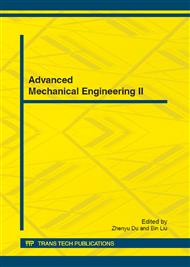p.211
p.217
p.222
p.227
p.233
p.237
p.242
p.247
p.255
Vibration Analysis of Coupled Faults Diagnosis in a Rotor System Using Wavelet De-Noising and KPCA Data Fusion
Abstract:
In a rotor system, simultaneous existence of coupled faults, i.e. a crack couples with a misalignment, is very common. However, the single fault diagnosis has been investigated extensively in previous work while the issue of coupled faults diagnosis (i.e. considering two or more than two faults at a time) has been addressed insufficiently. In order to detect the existence of coupled faults and to prevent a fatigue crack in the rotor shaft, a new method is proposed to analyze the vibration signals using the Wavelet de-nosing and kernel principal component analysis (KPCA) in this work. The Wavelet was firstly used to de-noise the original vibration signals, and then the KPCA was adopted to extract useful fault features for the coupled faults detection. A case study on the coupled fault diagnosis of the rotor system has been implemented. The diagnosis results demonstrate that the proposed method is feasible for the coupled fault diagnosis of rotor systems. The fault detection rate is 91.0%.
Info:
Periodical:
Pages:
233-236
Citation:
Online since:
July 2012
Authors:
Keywords:
Price:
Сopyright:
© 2012 Trans Tech Publications Ltd. All Rights Reserved
Share:
Citation:


